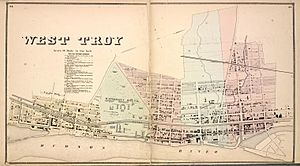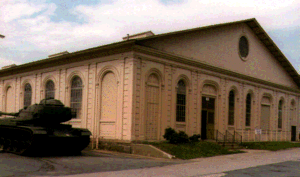Watervliet, New York facts for kids
Quick facts for kids
Watervliet
|
|
|---|---|
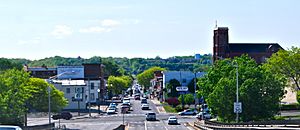
Watervliet as seen when entering the city on Congress Street Bridge from Troy
|
|
| Etymology: from Dutch, meaning 'water brook, water stream' | |
| Nickname(s):
The Arsenal City
|
|
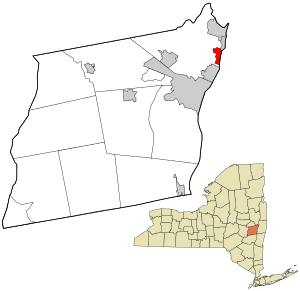
Location in Albany County and the state of New York.
|
|
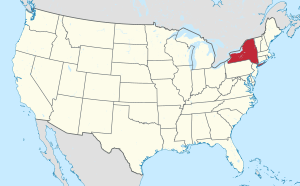
Location of New York in the United States
|
|
| Country | United States |
| State | New York |
| County | Albany |
| Incorporation as city | 1896 |
| Government | |
| • Type | City Hall |
| Area | |
| • Total | 1.47 sq mi (3.81 km2) |
| • Land | 1.34 sq mi (3.48 km2) |
| • Water | 0.13 sq mi (0.34 km2) |
| Elevation | 30 ft (9 m) |
| Lowest elevation | 0 ft (0 m) |
| Population
(2020)
|
|
| • Total | 10,375 |
| • Density | 7,731.00/sq mi (2,985.58/km2) |
| Time zone | UTC-5 (EST) |
| • Summer (DST) | UTC-4 (EDT) |
| ZIP Code |
12189
|
| Area code(s) | 518 |
| FIPS code | 36-001-78674 |
| FIPS code | 36-78674 |
| GNIS feature ID | 0968918 |
| Wikimedia Commons | Watervliet, New York |
Watervliet (/wɔːtərˈvliːt/ WAW-tər-vleet or /wɔːtərvəˈliːt/ WAW-tər-və-leet) is a city in northeastern Albany County, New York, United States. In 2020, about 10,375 people lived there. Watervliet is located north of Albany, which is the capital city of New York State. The city is surrounded on its north, west, and south sides by the town of Colonie. Watervliet is also known as "the Arsenal City" because of the important Watervliet Arsenal located there.
Contents
History of Watervliet
The explorer Henry Hudson first came to the Watervliet area around 1609. The first settlers arrived in 1643. This area was part of a large land grant called Rensselaerswyck, managed by Kiliaen van Rensselaer.
Early Transportation and Growth
In 1710, Derrick van der Heyden started a ferry service across the Hudson River to Troy. Soldiers used this ferry in 1777 during the American Revolutionary War on their way to the Battle of Saratoga. Another ferry began operating in 1786.
The larger town of Watervliet was created in 1788. It covered almost all of what is now Albany County. Because so many other towns were later formed from it, it's known as the "mother of towns" in the county. In 1816, the first post office opened and took the name Watervliet.
The area that is now the city of Watervliet was once made up of smaller communities. These included the village of Gibbonsville (started in 1824) and its neighbor, West Troy. There was also a small settlement called Washington, later known as Port Schuyler.
These communities grew side by side, but they had a friendly rivalry. They even named their streets differently! In 1824, Gibbonsville became an official village. Later, in 1836, West Troy became a larger village that included Gibbonsville and Port Schuyler. The Watervliet post office changed its name to West Troy in 1847.
Becoming a City
By 1895, the original large town of Watervliet had become much smaller. It was divided into the present-day city of Watervliet (which was then the village of West Troy), the town of Colonie, and the town of Green Island. In 1896, the city of Watervliet was officially formed.
Industry and Innovation
In the early 1800s, Watervliet became a busy manufacturing center. It was similar to nearby cities like Cohoes and Troy. This was thanks to bell foundries, which are factories that make bells.
One of the most famous was the Meneely Bell Foundry, started by Andrew Menelly, Sr. in 1826. This company made thousands of bells that are still used today all over the world!
A very important part of Watervliet's history is the Watervliet Arsenal. The U.S. government bought land here in 1813 to build it. It was founded during the War of 1812. The Watervliet Arsenal is the oldest federal arsenal in the country. Today, it is the only place in the U.S. that makes large cannons.
Transportation Hub
The main path of the Erie Canal, which connected Buffalo to Albany, ran through Watervliet. This canal was very important for moving goods. There were special "side-cuts" in Watervliet that allowed boats to easily connect to the Hudson River.
Watervliet was also connected by roads and railways. The Watervliet Turnpike, built in 1828, is now part of New York State Route 32. The Albany and Northern Railway connected Watervliet to Albany starting in 1852.
Local Government
The current mayor of Watervliet is Michael Manning, who was first elected in 2007. He is a member of the Democratic Party.
Several historic places in Watervliet are listed on the National Register of Historic Places. These include the Ohio Street Methodist Episcopal Church Complex, St. Nicholas Ukrainian Catholic Church, the Watervliet Arsenal, and the Watervliet Side Cut Locks.
Where is Watervliet?
 |
Town of Colonie
Hamlet of Maplewood |
Town and village of Green Island |  |
|
| Town of Colonie
Hamlets of Latham and Mannsville |
Hudson River
Rensselaer County City of Troy |
|||
| Town of Colonie
Hamlet of Schuyler Heights and Schuyler Flatts Cultural Park |
Geography and Landscape
Watervliet covers a total area of about 3.8 square kilometers (1.47 square miles). Most of this area, about 3.5 square kilometers (1.34 square miles), is land. The rest, about 0.3 square kilometers (0.13 square miles), is water.
The city is bordered on three sides by the town of Colonie. To the north is the hamlet of Maplewood. To the west are the hamlets of Latham and Mannsville. To the south is the hamlet of Schuyler Heights.
The northeastern part of Watervliet borders the town and village of Green Island. To the east, Watervliet is next to the Hudson River. The city of Troy is located across the river. Watervliet is mostly flat. However, it has a steep slope on its western edge, an area once known as "Temperance Hill."
Population and People
| Watervliet Historical Populations | ||
|---|---|---|
| Year | Pop. | ±% |
| 1840 | 4,572 | — |
| 1850 | 6,900 | +50.9% |
| 1860 | 8,952 | +29.7% |
| 1870 | 10,693 | +19.4% |
| 1880 | 8,820 | −17.5% |
| 1890 | 12,967 | +47.0% |
| 1900 | 14,321 | +10.4% |
| 1910 | 15,074 | +5.3% |
| 1920 | 16,073 | +6.6% |
| 1930 | 16,083 | +0.1% |
| 1940 | 16,114 | +0.2% |
| 1950 | 15,197 | −5.7% |
| 1960 | 13,917 | −8.4% |
| 1970 | 12,404 | −10.9% |
| 1980 | 11,354 | −8.5% |
| 1990 | 11,061 | −2.6% |
| 2000 | 10,207 | −7.7% |
| 2010 | 10,254 | +0.5% |
| 2020 | 10,375 | +1.2% |
| Notes: Census numbers for 1840 to 1890 are for the village of West Troy (incorporated 1836), which became the city of Watervliet in 1896. *1880 census was not considered accurate and estimates put population at roughly 11,000* Source: |
||
In 2020, the city of Watervliet had 10,375 people living in 5,070 households. Most residents, about 76.9%, were White. About 9.0% were African American, and 4.7% were Asian. About 8.0% of the population identified as Hispanic or Latino.
About 26.3% of households had children under 18 living with them. The average income for a household in the city was $46,345. About 21.2% of the population lived below the poverty line. This included 21.7% of those under 18 years old.
Famous People from Watervliet
- Richard B. Bates, a member of the Wisconsin State Assembly.
- Butch Byrd, a defensive back for the Buffalo Bills football team.
- T/Sgt. Peter J. Dalessandro, who received the Medal of Honor for his bravery.
- Melique García, an Olympic Sprinter.
- Rebecca Cox Jackson (1795–1871), an African-American freedwoman and spiritual leader.
- Isaac J. Lansing, a president of Clark Atlanta University and an author.
- Francis W. Martin (1878-1947), the first District Attorney of the Bronx.
- Leland Stanford, who founded Stanford University and was president of Southern Pacific Railroad.
See also
 In Spanish: Watervliet (Nueva York) para niños
In Spanish: Watervliet (Nueva York) para niños




